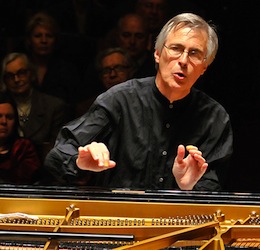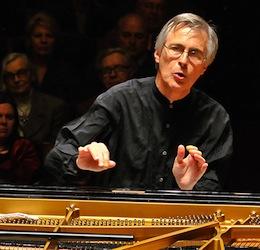
The beginning of the San Francisco recital debut of the German pianist and conductor Christian Zacharias, currently the principal conductor of the Orchestre de Chambre de Lausanne (Switzerland), was rather indicative. Presented by San Francisco Performances, the pianist appeared onstage at Herbst Theatre Friday at 10 seconds before 8 p.m., walked across the stage, took a bow, and precisely at twenty hundred hours sat down at the piano and commenced playing C.P.E. Bach’s Sonata — with the same immaculate precision. (At this point I fondly remembered a Swiss cab driver, who, after I had phoned from my hotel for a taxi, apologized profusely for arriving 35 seconds late.)
Piano sonatas of Carl Philipp Emanuel Bach (Johann Sebastian Bach’s second surviving son), despite their refined filigree, overwhelmed his contemporaries with precipitous changes of moods and seemingly incongruous sequences of musical events. Although the eccentricity bar is set pretty high in his sonatas, his rondos sound even more bizarre. Yet that was exactly what attracted both listeners and performers to his music, and his quirky rondos were apparently more popular than his sonatas. The composer himself realized this fact and often included rondos in collections of sonatas because many people bought his collections simply for the rondos.
Zacharias’ accounts of C.P.E. Bach’s Sonata in A Minor and Rondo in C Minor were beautifully crafted. The clarity of articulation never faltered. The sudden turns and feints of the composer’s fancy were effortlessly executed. Fleet, lighter-than-air passages intermingled with entreating melodies and incisive, almost beboplike syncopations.
Melodic lines were delivered with laidback, understated elegance.
Switching from C.P.E. Bach directly to late Brahms was quite a change, but during the opening two pieces we were conditioned for drastic changes. In Brahms’ Opus 119, the first three Intermezzos move through varying states of tenderness, and Zacharias was fully attuned to the composer’s lyrical world. The pianist wonderfully captured the introspective quality of the Intermezzos. Melodic lines were delivered with laidback, understated elegance; polyphony was thoughtfully brought out by gentle dislocations of the parts. Zacharias’ poised, if somewhat aloof, delivery was, however, less suited for the concluding Rhapsody. This energetic piece deserves to be played with far more rhythmic vigor and intensity.
And Now Let’s Hear From Ludwig and Franz
Beethoven’s Sonata Opus 110, which followed the Brahms set, presents a unique developing drama. The tranquil (for the most part) and affecting first movement is trailed by a raunchy scherzo, with its drunken stumbles. The third, slow movement is a “vocal” lament, marked “Arioso dolente.” The subsequent movement, a fugue, is supposed to provide a consoling response to the lament and bring the entire sonata to a close. In the late 18th through early 19th centuries, the fugue was considered an emblem of intellect, a Ph.D. form of the time, so to speak. Fugues supplied satisfactory solutions to various conundrums in Beethoven’s other works. For example, in his Fifth Symphony, the fugato in the middle of the Scherzo overcomes the menace of the so-called Fate motif, and the triumphant finale ensues.
In Opus 110, though, such a solution does not work. The arioso returns after the supposedly final fugue, even more despondent than before. Beethoven marked it in both German and Italian: “Ermattet” (exhausted; worn out) and “Perdendo le forze” (losing strength). The melody now is incessantly interrupted by numerous rests, as if the exhausted “singer” is gasping for breath. A new fugue materializes, and this time its theme is inverted. In this new appearance, the falling inflections of the theme sound considerably more consoling, but still not sufficiently so for a happy ending. The fugue wavers, the scherzo is momentarily recalled, and then Beethoven suddenly reverts to his old, tempestuous ways and finishes the sonata with a blazing flourish.
I must confess that I did not find Zacharias’ reading of Opus 110 entirely persuasive. The mellifluous simplicity of the first movement received an admirable treatment. But the scherzo lacked its bawdy countenance; it came out too civilized. And the second arioso was simply too equitable for the lament’s uncontrollable weeping. Afterward, however, everything got back on track and the conclusion of the sonata was rendered with robust confidence.
Schubert’s sprawling Sonata in D Major took the entire second half of the program. Although I would welcome more fire and rhythmic urgency in the first and third movements, Zacharias’ intimate lyricism, carefully sculptured textures, and probing music-making won the night. As an encore, the pianist chose homage to C.P.E. Bach’s earlier rondo: Mozart’s charming Rondo in D Major. The subtle joke of this piece is that, even though it’s titled “Rondo” and sounds like one, it’s actually a straightforward sonata form. Very funny. With that, the concert ended at precisely 22:00.

